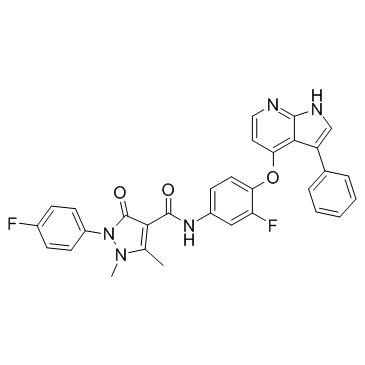1221713-92-3
| Name | N-(4-(3-phenyl-1H-pyrrolo[2,3-b]pyridin-4-yloxy)-3-fluorophenyl)-2-(4-fluorophenyl)-2,3-dihydro-1,5-dimethyl-3-oxo-1H-pyrazole-4-carboxamide |
|---|---|
| Synonyms |
2-(4-Fluorophenyl)-N-{3-fluoro-4-[(3-phenyl-1H-pyrrolo[2,3-b]pyridin-4-yl)oxy]phenyl}-1,5-dimethyl-3-oxo-2,3-dihydro-1H-pyrazole-4-carboxamide
2-(4-fluoro-phenyl)-1,5-dimethyl-3-oxo-2,3-dihydro-1H-pyrazole-4-carboxylic acid [3-fluoro-4-(3-phenyl-1H-pyrrolo[2,3-b]pyridin-4-yloxy)-phenyl]-amide 1H-Pyrazole-4-carboxamide, 2-(4-fluorophenyl)-N-[3-fluoro-4-[(3-phenyl-1H-pyrrolo[2,3-b]pyridin-4-yl)oxy]phenyl]-2,3-dihydro-1,5-dimethyl-3-oxo- NPS-1034 |
| Description | NPS-1034 is a dual inhibitor of AXL and MET with IC50s of 10.3 and 48 nM, respectively. |
|---|---|
| Related Catalog | |
| Target |
IC50: 10.3 nM (AXL), 48 nM (MET)[1] |
| In Vitro | NPS-1034 is a dual inhibitor of AXL and MET with IC50s of 10.3 and 48 nM, respectively.The expression and activity of AXL is significantly increased in HCC827/ER cells, and NPS-1034 treatment effectively inhibits its tyrosine phosphorylation[1]. NPS-1034 inhibits the viability of the MKN45 and SNU638 cell lines, which highly express the MET gene and p-MET (phosphorylated MET), with IC50 values of 112.7 and 190.3 nmol, respectively. In contrast, NPS-1034 inhibits AGS, KATOIII, NCI-N87, MKN1, MKN28, and MKN74 cell viability with IC50 values ranging from 1 μmol to more than 10 μmol. MET phosphorylation is dramatically decreased after treatment with NPS-1034 in the MKN45 cells, but not in the MKN28 cells. NPS-1034 inhibits hepatocyte growth factor (HGF)-stimulated MET autophosphorylation (Y1234/1235) in the AGS and MKN1 cell lines with IC50 values of <10 and <50 nmol, respectively. HGF-induced MET phosphorylation is completely inhibited by 50 nmol NPS-1034[2]. |
| In Vivo | NPS-1034 inhibits tumor proliferation, which highly expresses p-MET. NPS-1034 treatment induces a clear decrease in the vascularization of the tumors. The expression of alpha-smooth muscle actin (α-SMA) is decreased in the tumor sections of mice treated with NPS-1034. NPS-1034-treated mice show virtually no weight loss, indicating that NPS-1034 is generally well tolerated[2]. |
| Cell Assay | To perform the MTT assay, cells (0.5×104/well) are plated in 96-well sterile plastic plates and allowed to attach overnight. Cells are exposed to varying doses of NPS-1034 in medium containing 1% FBS. After 72 hours, 15 μL of MTT solution (5 mg/mL) is added to each well and plates are incubated for 4 hours. Crystalline formazan is solubilized with 100 μL of a 10% (w/v) SDS solution for 24 hours. Absorbance at 595 nm is read spectrophotometrically using a microplate reader[1]. |
| Animal Admin | Female severe combined immunodeficiency (SCID) mice (17 to 20 g, 6 weeks of age) are used. Tumors are grown by implanting 5×106 cells in Matrigel into the mouse flanks. Treatment of 5 mice per group is started when the tumors have reached a volume of 50 to 100 mm3 with vehicle control or NPS-1034 (10 mg/kg, 5 days a week). NPS-1034 is administered orally. Treatment is stopped at the indicated day and mice are followed-up for tumor recurrence. To measure tumor size, the length (L) and width (W) of the tumor are measured with calipers, and tumor volume (TV) is calculated as TV=(L×W2)/2. Immunohistochemical staining is performed using a specific primary antibody, the EnVision Plus staining kit, and the APO-Direct terminal deoxynucleotidyl transferase-mediated dUTP nick end labeling assay kit, according to the suppliers' instructions. Quantitative analysis of section staining is performed by counting immunopositive cells in 5 arbitrarily selected fields at ×40 magnification[1]. |
| References |
| Density | 1.4±0.1 g/cm3 |
|---|---|
| Molecular Formula | C31H23F2N5O3 |
| Molecular Weight | 551.543 |
| Exact Mass | 551.176880 |
| PSA | 93.94000 |
| LogP | 5.61 |
| Index of Refraction | 1.695 |
| Storage condition | -20℃ |
